Work Permits
Optimize and streamline authorization management with Field – Work Permits. Take your validation processes to the next level with greater control, efficiency, and security.
You can manage everything from the simplest processes, where signers only validate the data entered at the end of a Work Permit document, to more complex processes where the workflow requires validations, signatures, and authorizations that are passed from one mobile device to another.

WHAT IS WORK PERMIT MANAGEMENT?
It is a process that seeks to ensure safety, operational efficiency, and regulatory compliance in specific activities within a company.

Work and Hazard Identification
• Detailed description of the task.
• Hazard identification (chemical, electrical, mechanical, environmental).

Required authorizations
• Supervisors and safety officers.
• Applicants, authorizers, executors, and any other roles associated with the matter.

Training and Competence
• Verification that workers are trained.
• Certifications for specific tools and machinery.

Planning and Control
• Clear procedures for performing the work.
• Control measures: power outages, ventilation, use of PPE.

Recording and Traceability
• Documentation of the permit from issuance to closure.
• Records available for audits.

Permit Monitoring and Closure
• Detailed description of the task.
• Hazard identification (chemical, electrical, mechanical, environmental).
COMMON TYPES OF WORK PERMITS

Work at Height:
Tasks performed at heights specified by regulations.
Electrical Work:
Maintenance or repairs on electrical installations.
Hot Work:
Activities that generate heat or sparks (welding, cutting).
Confined Spaces:
Work in places with limited access and hazardous atmospheres.
Excavations:
Tasks that involve removing earth with risks of collapse or interference.
COMMON TYPES OF WORK PERMITS
Work at Height:
Tasks performed at heights specified by regulations.
Electrical Work:
Maintenance or repairs on electrical installations.

Hot Work:
Activities that generate heat or sparks (welding, cutting).
Confined Spaces:
Work in places with limited access and hazardous atmospheres.
Excavations:
Tasks that involve removing earth with risks of collapse or interference.
This procedure ensures that the risks associated with certain tasks are identified and mitigated before they begin, especially in high-risk jobs.
Benefits of Good Permit Management
With Field Work Permits, you not only significantly reduce downtime, which requires identifying those responsible for the various tasks, but also enable a continuous improvement process based on the calculation of management indicators.

Safety
Minimizes workplace accidents.

Legal Compliance
Avoids penalties for violating health and safety regulations.

Efficiency
Ensures that work is carried out in an orderly and planned manner.

Trust
Promotes a safe work environment where employees feel protected.
DIGITAL PERMIT MANAGEMENT

With the app, you can clearly see all the stages a permit must go through, such as Authorization, Production Demo, and Shaft Closure. In this example (400020), the permit has already passed the first two stages and is ready for Shaft Closure signature, ensuring a streamlined and transparent workflow.



Comparison Chart: Manual and Field Management – Work Permits
Aspect
Manual
Management
WORKS PERMITS
Physical, paper usage, and manual
transfer
High due to delays and manual coordination
High, due to printing, data storage, and retrieval
Limited, fixed forms
Nonexistent
Frequent, handwritten
Automatic, with notifications between stakeholders
Elevados por demoras y coordinación manual
Low, paperless, and with digital access
Flexible form creation and modification
Configurable metrics for analysis and decisions
Reduced, standardized, and automated attendance
Cuadro comparativo Gestión Manual y Field – Permisos de Trabajo
[smartslider3 slider=”2″]








